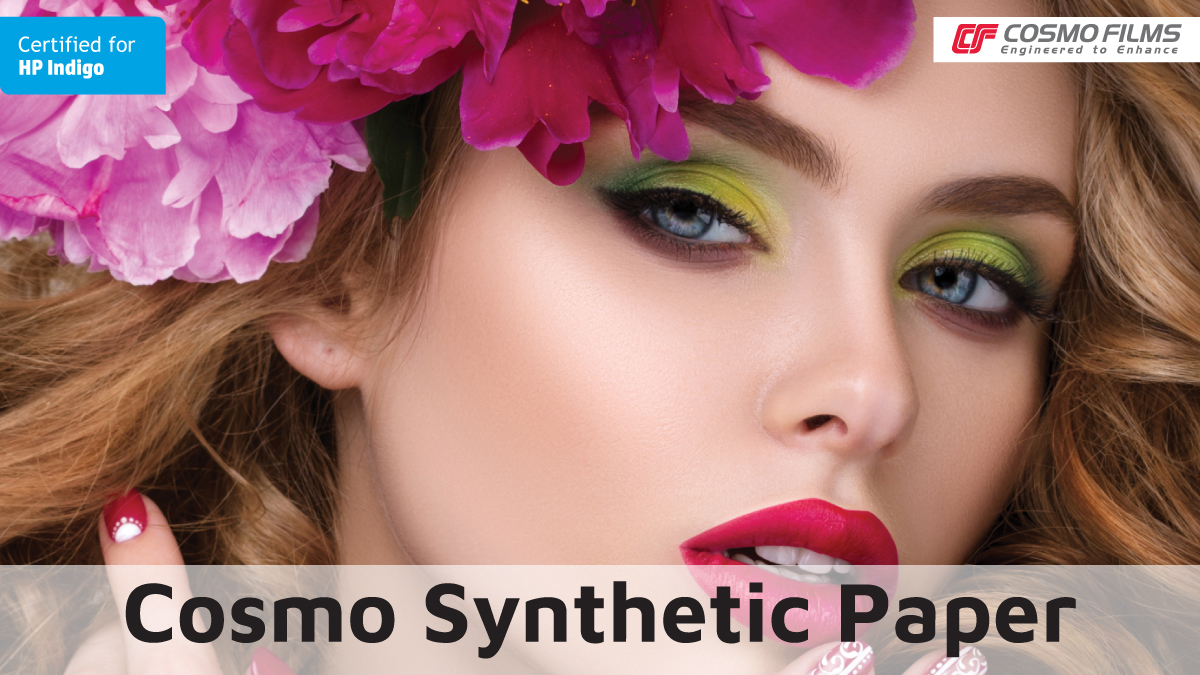Engineered by industry experts, Cosmo Synthetic Paper has turned out to be the best replacement for pulp based paper. What makes it the first choice of businesses today is its non-tearability, moisture & chemical resistance and excellent Printability. CSP is compatible with diverse printing technologies like Conventional Offset, UV Offset, UV Flexo printing, Water based Flexo printing, Thermal Transfer, Screen, Letterpress, UV Inkjet, HP Indigo & HP Latex printing and selective Laser Print technologies. Here are some of the printing recommendations for printing on Cosmo Synthetic Paper.
Printing Recommendations*
- Off-set Printing
Off-set printing for CSP requires some additional care than a wood-pulp paper. This is because on a normal paper, the ink dries by absorption and oxidation but on CSP, the ink would only be able to dry out with surface oxidation. Thus, the process would take a little longer and if not allowed to dry properly, the user might face ink set off issues. To avoid this, following precautions are necessary:
1. Pre-print stacking – The advisable limit is not more than 3000 sheets. Air conditioning should be adequate before you could start the printing in order to ensure smooth movement of sheets. Vacuum can cause suction marks and thus, needs to be reduced.
2. Inks – Oil-based offset printing inks are the most compatible with CSP as they undergo evaporative and oxidative polymerization drying mechanisms. On the other hand, conventional inks can also be used but would need more time to dry. While choosing an ink for CSP, following things should be kept in mind:
– Ink should be able to set quick or dry fast
– Ideal for two side printing
– Results in even surface to reduce set off
– Compatible with UV curable inks
3. Dampening System – The dampening level should be minimal as otherwise, it can cause set off. Multicolour printing contains excessive water and thus can lead to improper ink transfer.
4. Dampening Water Criteria – Following characteristics should be maintained for great results:
– Water Level: Minimum as per machine parameters to eliminate emulsification
– pH Level: 4.5 to 5.5 (Acidic) to avoid emulsification of inks used
– Temperature: 8-10° C
– Alcohol Content: 5-10% for faster drying of dampening water
5. Delivery – Generally, up to 3 inches of stacking is recommendable. That said, it can vary as per the sheet size, ink deposition, amount of powder sprayed and printing pattern. - Flexographic Printing
CSP is compatible for flexography too. However, it may require proper ink selection for which you may consult the manufacturer. Tension should be set at the lowest level possible to avoid misregistration. You also need to maintain an ideal temperature of not more than 80° C during printing & thereafter, close to room temperature. - Digital Printing
For this, the below precautions need to be taken:
– Selecting correct media setting carefully
– Conducting tests of the material prior to its use
– Conditioning sheets in the printing environment for 24 hours
– Fanning the required number of sheets for jam-free feeding
– Maintaining temperature between 20-25° C
– Setting adequate fusing temperature & pressure as per OEM recommendations
– Lamination is recommended post printing for extended life
- Off-set Printing
- Thermal Transfer (TTR)
This process of printing uses carbon ribbon which is moved to substrate upon heating. It is recommended to test suitable energy & speed combinations for printing with different ribbons. Some compatible Resin Ribbons are Armor AXR 7+, Ricoh B110CR, Mastercorp TTR Z400. Amongst Wax Resin Ribbons, Armor AXR FH 7+ and Ricoh B110A are compatible.
- Digital Laser Printing (Dry Toner)
Laser Printing with dry toner is tested to be suitable for one of CSP’s variants, namely, Matte White Both Side Coated. Liquid toner, on the contrary, cannot be used as CSP does not facilitate ink drying through penetration but surface oxidation. Some recommendations for printing through this technology are- - Proper fanning of sheets is required prior to loading in the tray
- It is recommended to involve the service engineer for media setting
- If required, adjust image transfer current to get good quality print results
- Please ensure proper earthing of the machine
- Suggested to use external static eliminator device for higher productivity
- Maintain room temperature between 20-25 degree C & relative humidity at 55% +- 10%
- Apart from the above, CSP has been tested to be suitable for Letterpress and Screen Printing technologies as well.
*Disclaimer: These printing recommendations are applicable to all variants of CSP. In case of top-coated products, printing is recommended only on the coated side. A few trials should be carried out before using it in bulk to ensure smooth functioning.

Converting Recommendations of CSP
With properties of both plastic film & paper, CSP can be folded (scoring or 30 minutes nipping is recommended for optimal results), perforated, guillotined and punched. It can also be used for die cutting and hot foil stamping.
Cosmo Synthetic Paper has made everything simpler than ever with its versatility in terms of printing, features and usability. It can replace pulp based paper in applications requiring durability and longevity, thus providing an eco-friendly solution to the problem of cutting down trees to make paper.


